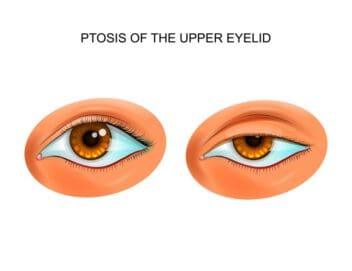Further Reading
- Visian ICL: Comparison Guide
- Blepharoplasty Insurance Coverage
- WaveLight LASIK
- Contoura LASIK Surgery
- What Does LASIK Feel Like?
- LASIK & Military Service
- LASIK After Cataract Surgery
- Pattern Scanning Laser (PASCAL) Technology
- SMILE vs. LASIK
- SMILE
- LASIK or LASEK?
- Pros and Cons: Is It Worth It?
- Custom LASIK
- Zyoptix
- Wavefront LASIK
- Color Blindness
- What Is Corneal Cross-Linking?
- Blade vs. Bladeless
- Blepharoplasty Surgery
- How Many People Get LASIK Each Year
Ptosis Surgery: Costs, Recovery & More
Home / Laser Eye Surgery Guide (Updated) /
Last Updated:
Ptosis is a condition that occurs in both children and adults because of excess skin and a long or weak levator muscle in the eyelid, causing drooping eyelids.
Table of Contents
Children may have congenital ptosis, which occurs very early in life. It may require medical treatment to reduce the risk of other poor vision problems like amblyopia.
Adults may develop ptosis due to age because muscles and skin weaken over time, causing drooping eyelids. In some instances, ptosis can be caused by a tumor, a muscle disease, or a nerve disease that requires different treatment.

The most common form of ptosis surgery is blepharoplasty, which tightens the muscle and removes excess skin. For children, however, there are other approaches to ptosis surgery that use different muscle groups to keep the eyelid open.
If your ptosis surgery is medically necessary, work with your ophthalmologist to ensure the procedure is covered by your vision insurance so that you don’t have to face all of the ptosis correction surgery cost.
Ptosis: Do Your Drooping Eyelids Require Surgery?
Ptosis is the medical name for “drooping eyelids,” a condition that can occur as you get older, or it can appear in young children. While adult ptosis is more cosmetic than problematic, drooping eyelids can cause vision problems in children, like amblyopia.
If your eyelid droops a little over your eye, you might choose a cosmetic version of blepharoplasty, an eyelid surgery, to adjust the lid so it looks more like your other eye. In some cases, especially in children, blepharoplasty is an important medical procedure to restore or maintain good vision.
This condition is very treatable if it causes vision problems. Often, someone with ptosis can spend years with a drooping eyelid and never notice any changes in their vision. Your optometrist or ophthalmologist will monitor any progression to see if the lid falls far enough that you need surgery to remove excess skin.
Different Types of Ptosis in Children & Adults
Ptosis can occur in both children and adults. The condition may not be impactful for either age group, or it could cause enough harm to your vision that you need surgery. An optometrist or ophthalmologist will manage ptosis differently based on the age of their patient, as ptosis can lead to more serious problems in children compared to adults.
- Children: If a child is born with ptosis, it is called congenital ptosis. Often, ptosis that occurs in children is caused by problems in the muscle that lifts the eyelid, known as the levator muscle.Drooping upper eyelids are the most common sign of ptosis, but other signs include:
- Eyelid creases not lining up with each other.
- The child tipping their head back to see more clearly.
- The child raising their eyebrows to see more clearly.
A child with ptosis may have other eye problems that are exacerbated by ptosis, like amblyopia. This is a condition involving weak muscles in one eye, so the eye turns inward or outward, and the eye’s connection to the brain becomes weak. If the eyelid droops too far, the child may develop crossed eyes because of misaligned vision. Children with ptosis may also have astigmatism, or generally blurry vision due to an irregularly shaped cornea.
Ptosis in children can also indicate an underlying condition like eye movement diseases, muscle diseases, or a tumor on the eyelid or inside the eye. Working with a pediatric ophthalmologist will help your child get an appropriate diagnosis and treatment plan.

When treating ptosis in children, ophthalmologists consider:
- The child’s age.
- If one or both eyelids are involved.
- Eyelid height.
- Eye movements.
- The strength of the eyelid muscle.
Most children with ptosis have minor surgery to tighten the eyelid muscle or to remove excess skin or fat. This improves vision so the child is less likely to struggle with other vision problems later in life.
Congenital ptosis typically appears early in life and does not get progressively worse. If it is mild, your child’s optometrist may not treat the condition immediately. They may monitor your child for signs of other vision problems.
- Adults: Involutional ptosis occurs in adults, when the levator muscle stretches or separates away from the eyelid. Aging is the most common cause of this type of ptosis, but an eye injury or disease may also lead to the condition. Sometimes, cosmetic eye surgery can cause ptosis as a side effect. If you have ptosis as an adult, it may look worse than it is. Your optometrist or ophthalmologist can work with you to monitor changes and determine if surgery would improve your vision.
Age is the most common cause of ptosis in adults, but nerve or muscle diseases may affect how the eyelids move over your eyes. For example, ptosis can be one of the first symptoms of myasthenia gravis, a rare disorder impacting how muscles respond to your nerves. This is a progressive disease that eventually leads to muscle weakness in the face, arms, legs, and other parts of the body. There may be local problems in or around the eye, like a tumor.
As with ptosis in children, it is important to work with an optometrist or ophthalmologist to discuss all your symptoms and determine if there is a more serious underlying cause of your ptosis.
Surgery for adult ptosis is an outpatient procedure, meaning you receive local anesthesia and will return home the same day as the operation. Your surgeon may only make a small adjustment in the amount of skin on your eyelid so it no longer droops, or the procedure may involve adjusting the levator muscle, so it holds the eyelid in place more effectively.
Unlike congenital ptosis, adult ptosis gets progressively worse. Your eye doctor will monitor the condition during regular checkups and let you know when they think surgery is a good option.
If ptosis appears suddenly in you or your child, getting worse in a matter of hours or days, this may indicate a medical emergency. You may also experience symptoms like double vision, weakness of the facial muscles, weakness in the arms or legs, trouble speaking or swallowing, or severe headache; these warrant immediate medical attention. If ptosis is accompanied by redness or swelling in the eye, you should see your eye doctor on an emergency basis immediately.

Types of Ptosis Surgery
While blepharoplasty is the most common form of ptosis surgery for adults, there are several other procedures to correct ptosis in children. These procedures involve adjusting muscles so there is a different dominant muscle group holding the eyelid up and assisting with blinking.
- Blepharoplasty: This is a type of cosmetic surgery that removes skin, muscle, or fat deposits in the eyelid that create a drooping appearance.This is an anti-aging treatment rather than a medical treatment, so it may not be covered by insurance. For some adults, blepharoplasty will restore sight and can be considered a medical treatment for ptosis. The American Society of Plastic Surgeons (ASPS) reports that the average cost of blepharoplasty is $3,022.Blepharoplasty is an outpatient procedure that requires about two weeks of total healing time. During this period, you should avoid strenuous physical activity, putting things like contact lenses or makeup in or around your eyes, or rubbing your eyes excessively. Blurry vision, swelling, mild eye pain, and sensitivity to light are common side effects that should decrease as your eyelids heal. If they do not decrease or they get worse, let your doctor know before your surgery follow-up appointment.
- Traditional frontalis sling: This is a type of eyelid surgery that works better for congenital ptosis than adult ptosis. A link is created between various muscles in the upper eyelid, creating a better position of the eyelid using stronger muscle groups.Slings can be made from nylon, silk, polyester, silicone, stainless steel, and many other materials, with different appearances and ptosis recurrence rates. The surgeon can use either a single or double loop of the sling material, which does not affect the success rate of the procedure.Side effects include some eyelid lag when the child gazes down. The recurrence of ptosis 20 months after this operation is about 26 percent.
- Levator resection and advancement: This approach to treating congenital ptosis shortens the levator muscle if the child has less than 5 millimeters of levator function. Small incisions are used, and there is very little local anesthetic needed, so the results have a better cosmetic appearance.In a review of 100 surgeries, about 19 percent of ptosis cases were undercorrected, while about 7 percent were over-corrected. After about six months, 74 percent of ptosis cases were corrected.
- Whitnall sling: This procedure is a good choice for congenital ptosis in which there is between 3 and 5 millimeters of levator muscle function. This uses the second support structure of the eyelid, and many of the muscle groups in the eyelid remain intact. After the operation, there is a risk of corneal scratching or damage, poor eyelid creasing, conjunctival prolapse, lagophthalmos (the inability to close the eyes completely), or feeling like there is a foreign body in the eye.
- Frontalis muscle flap. This eyelid operation is recommended for ptosis cases in which the eyelid has about 4 millimeters of function. This surgery is like the frontalis sling procedure, but it uses existing tissue in the eyelid rather than inserting a device. Complications include eyebrow asymmetry, extreme upward or downward gaze, inability to close the eyelids completely, and overcorrection if the frontalis muscle is significantly stronger than the levator muscle.
- Müllerectomy: This procedure uses Muller’s muscle in place of the levator muscle to move the eyelid up and down. Complications of the operation include scratches or damage to the cornea, hemorrhage, and infection. Some damage to the cornea can be serious enough to require a secondary procedure to correct it.
Difference Insurance Coverage for Medical vs. Cosmetic Ptosis Surgery
Ptosis surgery for children is generally medically necessary, and insurance will cover at least part of ptosis correction surgery cost. In contrast, blepharoplasty may be considered cosmetic.
If you are an adult with ptosis, and it is medically necessary for you to undergo blepharoplasty, talk to your ophthalmologist and insurance provider first to ensure your vision insurance covers the procedure.
References
- What Is Ptosis? (October 2019). American Academy of Ophthalmology (AAO.org).
- Drooping Eyelids (Ptosis). (May 2017). Harvard Health Publishing, Harvard Medical School.
- Ptosis: Droopy Eyelid Causes and Treatment. (July 2017). Healthline.
- Current Techniques in Surgical Correction of Congenital Ptosis. (April–June 2010). Middle East African Journal of Ophthalmology.
- What to Expect From Blepharoplasty. (November 2017). Healthline.
The information provided on this page should not be used in place of information provided by a doctor or specialist. To learn more, read our Privacy Policy and Editorial Policy pages.
Further Reading
- Visian ICL: Comparison Guide
- Blepharoplasty Insurance Coverage
- WaveLight LASIK
- Contoura LASIK Surgery
- What Does LASIK Feel Like?
- LASIK & Military Service
- LASIK After Cataract Surgery
- Pattern Scanning Laser (PASCAL) Technology
- SMILE vs. LASIK
- SMILE
- LASIK or LASEK?
- Pros and Cons: Is It Worth It?
- Custom LASIK
- Zyoptix
- Wavefront LASIK
- Color Blindness
- What Is Corneal Cross-Linking?
- Blade vs. Bladeless
- Blepharoplasty Surgery
- How Many People Get LASIK Each Year